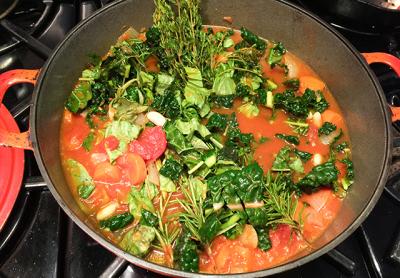Seasons by the Sea: Cooking 101

It’s that time of year. Perhaps you are sending a daughter or son off to college, or in my case, helping a son set up his first singleton apartment. Hopefully, by now, you have taught your offspring one of the most important life skills: how to cook for his or herself. If you haven’t, woe be to those children, for they will be eating Domino’s pizza and Subway sandwiches and bagels from the cafeteria.
Some colleges and universities have meal plans and some do not. Your darling may be in a dorm room where cooking is not feasible or even allowed, but she may also be moving into her own or a shared apartment and be faced with preparing her own three squares a day.
When I attended Kenyon College in Ohio, they used a food service called Saga. There were four levels of quality: A, B, C, and D. D was for prisons and mental hospitals, C was not much better, A and B were for nice hotels and clubs. Our college had C. Hence I gained 25 pounds freshman year, because I survived on a gloppy concoction of cottage cheese, peanut butter, honey, and granola. Campus housing was 90 percent dormitories with no facilities for cooking your own food.
My son attended McGill University in Montreal, which has no meal plan. His roommates freshman year were Canadian hockey players, and as far as I can tell they all subsisted on a jumbo jar of peanut butter and beer. (The drinking age is 18 in Canada.) But my intrepid gourmet found the cheap, ethnic food courts of the underground shopping malls and survived on the relatively balanced Ethiopian, Middle Eastern, and Korean foods he found there. He did not succumb to the ghastly Tim Horton’s doughnuts found on every street corner, nor poutine, the national Quebecois dish of French fries topped with cheese curds and smothered in gravy.
If your child is fortunate enough to have cooking facilities in his dorm or apartment, here is a simple primer to get him started. First, equipment. Every kitchen needs three basic knives and they must be high quality and kept sharp: a paring knife, a chef’s knife, and a bread knife.
Teach him how to sharpen the first two. You do know how to sharpen knives, don’t you? Second, two frying pans, one cast-iron and one nonstick. Cast-iron frying pans are cheap and can be used for baking as well as searing, sauteeing, frying, etc. For both pans, you might as well have 10-to-12-inch sizes; they are more versatile than several small ones. For the nonstick pan, I’m sorry to say you’ll have to get a moderately expensive one because it will last longer and is made with safer materials than the Teflon of yore.
Next, get a large enough pot with a steamer basket so he can make any manner of steamed vegetables and pasta, pasta, pasta. If your darling really does like to cook, treat him to a Dutch-oven casserole. This is perfect for chilies, soups, stews, anything that calls for long, slow, even cooking. And by the way, you can often find these in perfect condition at yard sales and thrift stores. They are virtually indestructible. I am still using the Dutch ovens that my grandparents and parents used.
Now, let’s be ever so hopeful that your child will make and eat salads often, so give him a nice wooden salad bowl with serving implements. Or a set of stainless steel or glass bowls that can do double or triple duty. A few of the boring necessities are a can opener, a set of measuring cups, baking sheet, a microplane grater (for grating ginger, garlic, nutmeg, etc.), two spatulas, two big spoons, oven mitts or pot holders, and some dish towels.
Let him pick out his own. I was very unsuccessful in trying to pawn off some old, blue-flowered dish towels on my son. For glassware you can’t go wrong with Duralex, the cheap French, almost unbreakable glasses that come in a variety of sizes. For flatware, I recommend solid pieces. Don’t be tempted by the colorful, plastic-handled sets. Someone will inevitably leave them soaking in the sink for a few days, and they will fall apart.
Lastly, give him one or two good, basic cookbooks like “The Joy of Cooking” or Fannie Farmer’s “Boston Cooking School Cook Book.” If your son or daughter is a vegetarian, give him or her a Deborah Madison or old school Moosewood cookbook.
I say this over and over to young people and non-cooks and newlyweds: If you know how to roast a chicken and make a decent vinaigrette, you can cook for anyone, anytime. Shortcuts are okay, too. Get some already cooked brown rice from your local Chinese takeout and make fried rice with it. Take advantage of salad bars to get the ingredients you need to make a good salad at home. Buy the preshredded cabbage from the supermarket to save time on coleslaw or the recipe for okonomiyaki.
Always have a well-stocked pantry with canned tuna, beans, pasta, and tomato sauces. If you keep eggs, onions, shallots, Parmesan, and other cheeses in your fridge, you will always have an omelette at your fingertips within five minutes. Keep a loaf of sliced, whole-grain bread in your freezer; just take out what you need when you need it. Frozen peas and chopped spinach are damned adequate staples to keep in the freezer as well.
Don’t let your soon-to-be-independent child rely on crappy cafeteria food, overseasoned, fatty takeout, or the glop I ate in college for his or her meals. Teach this most important of life skills and he or she will be healthier, more independent, and will save a lot of money to boot!
Click for recipes
